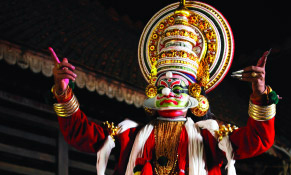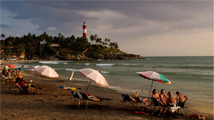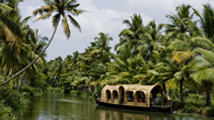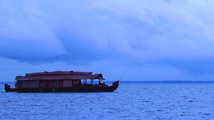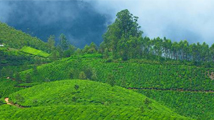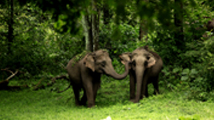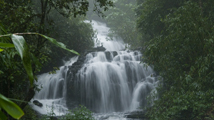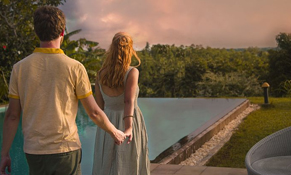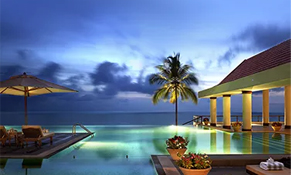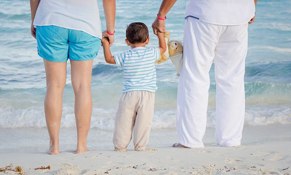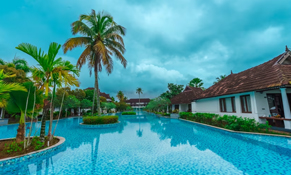The eventful history of this city began when a major flood in AD 1341 threw open the estuary at Kochi, till then a land locked region, turning it into one of the finest natural harbours in the world. Kochi thus became a haven for seafaring visitors from all over the world and became the first European township in India when the Portuguese settled here in the 15th century.
The Dutch wrested Fort Kochi from the Portuguese in AD 1663 and later in the last phase of the colonial saga, the British took over, the town in 1795. During 1660’s, Fort Kochi peaked in stature as a prime commercial centre and its fame spread far and wide – variously as a rich trade centre, a major military base, a vibrant cultural hub, a great ship building centre, a centre for Christianity and so on. Today, centuries later, the city is home to nearly thirteen communities.
A few interesting sites included in the tour are the Chinese fishing nets along the Vasco Da Gama Square, Santa Cruz Basilica, St.Francis Church, VOC Gate, Bastion Bungalow etc. Apart from these architectural splendors, an array of restaurants serving fresh seafood are also popular among tourists. The Chinese fishing nets erected on teak wood and bamboo poles work on the principle of balance. Records say they were first set up here between AD 1350 and 1450. Vasco Da Gama Square, the narrow promenade that parallels the beach, is the best place to watch the nets being lowered and pulled out of the sea.
The Santa Cruz Basilica, a church built originally by the Portuguese and elevated to a Cathedral by Pope Paul 1V in 1558, was spared by the Dutch conquerors who destroyed many Catholic buildings. Later the British demolished the structure and Bishop Dom Gomez Vereira commissioned a new building in 1887. Consecrated in 1905, Santa Cruz was proclaimed a Basilica by the Pope John Paul II in 1984.
Fort Kochi is also home to one of India’s oldest churches – the St.Francis Church. This was a Roman Catholic Church during the Portuguese rule from 1503 to 1663, then a Dutch Reformist Church from 1664 to 1804, and Anglican church from 1804 to 1947. Today it is governed by the Church of South India (CSI). Another important fact about the church is that Vasco Da Gama, who died in 1524, was buried here before his mortal remains were returned to Portugal 14 years later… Each and every structure, street, door, window and brick in Fort Kochi has several stories to tell.
Fort Kochi is accessible by bus or ferry. The bus ride from Ernakulam town, which is nearly 13 km away, takes about an hour and the ferry ride from Main boat jetty at Ernakulam about 20 minutes.
Tourist Spots within Kochi are as under:
Bolgatty Palace:This Dutch palace is situated on the Bolghatty island. At present it is being used as hotel. The island has a fine golf course and the panoramic view makes it an attractive picnic spot. Frequent boat service is available from the mainland Chinese Fishing nets: The chinese fishing nets found here are the only ones of its kind in India. It is believed that traders from the court of the Chinese ruler Kublai Khan introduced these nets here. Erected here between 1350 and 1450 AD by traders from the court of Kublai Khan, these nets are set up on Teak wood and bamboo poles. The best place to watch the nets being lowered into the sea and catch being brought in is the Vasco da Gama Square, a narrow promenade that runs along the beach. The Square is ideal place to idle, with stalls serving fresh delicious sea food, tender coconut etc Dutch Palace: The Dutch Palace was originally built by the Portugese. Later, in 17th century, the Dutch modified it and presented to the Raja of Kochi. Coronation of many Rajas of Kochi were held here. The place has a fine collection of mural paintings depicting the scenes from the Hindu epics Mahabharatha and Ramayana. Pierce Leslie Bungalow: This charming mansion was the office of Pierce Leslie & Co., coffee merchants, founded in 1862. A representative of the Fort Kochi colonial bungalow, this building reflects Portuguese, Dutch and local influences. Characteristic features are wood panels that form the roof of the ground floor, arched doors and sprawling rooms. Waterfront verandahs are an added attraction. Santa Cruz Basilica: This historic church was built by the Portguese and eleveated to a Cathedral by Pope Paul IV in 1558. in 1795 it fell into the hands of the British when they took over Kochi, and was demolished. About a hundred years later Bishop Dom Gomez Ferreira commissioned a new building at the same site in 1887. The Church was proclaimed a Basilica in 1984 by Pope John Paul II. Hill Palace: Built in the 19th century by Raja of Kochi, the Kochi province was ruled from here. The palace has been converted into a museum displaying a fine collection of articles used by the Rajas of Kochi apart from many archaeological findings. Jew Town: The area around the Synagogue is a centre of spice trade and curio shops. Museum of Kerala History: The museum has on display life size statues of many famous personalities and several paintings depicting Kerala History. Cherai Beach: This lovely beach bordering Vypeen island is ideal for swimming. Dolphins are occasionally seen here. Pallipuram Fort: It is the oldest European fort built in India. Parikshit Thampuran Museum: The museum is situated near the famous Siva Temple, Ernakulam. It houses a treasure of archaeological findings and relics including old coins, sculptures, oil paintings and murals. St Francis Church: It is the oldest church built by European in India.On his 3rd visit to Kerala, Vasco da Gama, the Portugese trader who reached India from Europe by sea, fell ill and died in Kochi. He was buried in the St. Francis Church. Later his remains were taken back to Portugal. In spite of that the exact place where he was buried has been marked out inside the church Nearest railway station : Ernakulam about 1 1/2 km from the Main boat jetty.Nearest airport : Cochin International Airport, about 20 km

